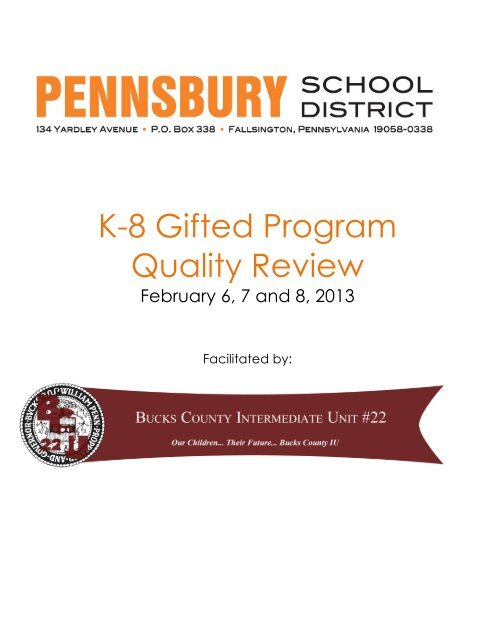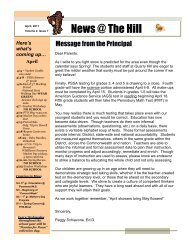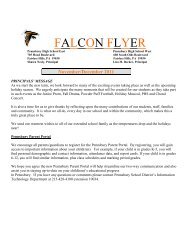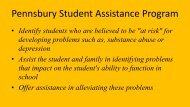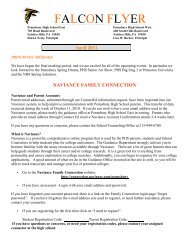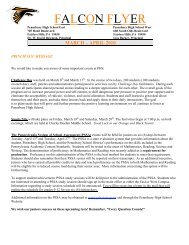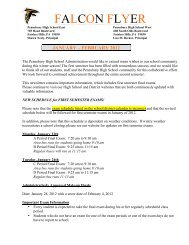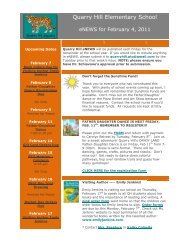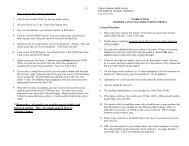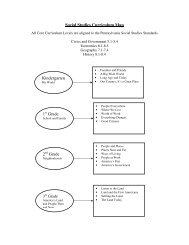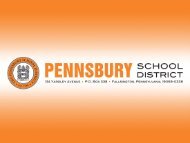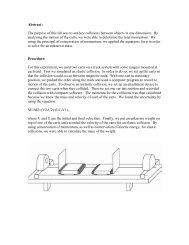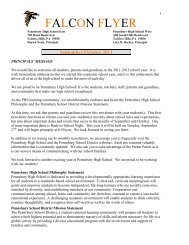K-8 Gifted Program Quality Review - Pennsbury School District
K-8 Gifted Program Quality Review - Pennsbury School District
K-8 Gifted Program Quality Review - Pennsbury School District
Create successful ePaper yourself
Turn your PDF publications into a flip-book with our unique Google optimized e-Paper software.
K-8 <strong>Gifted</strong> <strong>Program</strong><br />
<strong>Quality</strong> <strong>Review</strong><br />
February 6, 7 and 8, 2013<br />
Facilitated by:
To the <strong>Pennsbury</strong> <strong>School</strong> <strong>District</strong>:<br />
March 2013<br />
The K-8 <strong>Gifted</strong> <strong>Program</strong> <strong>Quality</strong> <strong>Review</strong> Team would like to thank and commend those who<br />
participated in the <strong>Pennsbury</strong> <strong>School</strong> <strong>District</strong> review process. We greatly appreciate the positive<br />
and professional attitude displayed by school staff and administration.<br />
The visiting team found the administration, teachers, staff, students and parents to be most<br />
cooperative and willing to discuss all aspects of <strong>Pennsbury</strong>’s gifted programs. Graciousness,<br />
openness and hospitality were evident throughout the three-day visit, making our jobs much<br />
easier and allowing us to collect useful information.<br />
Over the course of one hundred and nineteen individual and group interviews and classroom<br />
observations, the team collected information in a variety of areas and provided detailed answers<br />
to specific questions, along with overall program strengths, needs and recommendations. Team<br />
members identified program needs and made practical recommendations by applying their<br />
experience in the field to the information available, realizing that local conditions will determine<br />
local action.<br />
Team members were pleased to have had the experiences offered by this process. We wish you<br />
continued success in what is probably the most significant activity for today and tomorrow –<br />
educating our children.<br />
The Evaluation Team<br />
2
Introduction<br />
Overall Impressions<br />
TABLE OF CONTENTS<br />
K-8 <strong>Gifted</strong> <strong>Program</strong> <strong>Quality</strong> <strong>Review</strong> Report<br />
Question 1: Screening and Identification of <strong>Gifted</strong> Students<br />
Questions and Findings<br />
Strengths, Needs and Recommendations<br />
Question 2: Meeting the Individual Needs of <strong>Gifted</strong> Students<br />
Questions and Findings<br />
Strengths, Needs and Recommendations<br />
Question 3: Staff Development<br />
Questions and Findings<br />
Strengths, Needs and Recommendations<br />
Question 4: Best Practices, Technology and Resources<br />
Questions and Findings<br />
Strengths, Needs and Recommendations<br />
Question 5: Goals Objectives, Philosophy and Vision<br />
Questions and Findings<br />
Strengths, Needs and Recommendations<br />
Question 6: Coordination and Communication<br />
Questions and Findings<br />
Strengths, Needs and Recommendations<br />
Page<br />
3
<strong>Pennsbury</strong> <strong>School</strong> <strong>District</strong><br />
K-8 <strong>Gifted</strong> <strong>Program</strong> <strong>Quality</strong> <strong>Review</strong><br />
February 6, 7 and 8, 2013<br />
Prepared by the Bucks County <strong>School</strong>s Intermediate Unit #22<br />
The Intermediate Unit <strong>Quality</strong> <strong>Review</strong> Process provides a thorough examination of school<br />
programs and services by an experienced team of educators and specialists. Through this<br />
process, the Intermediate Unit and Bucks County school districts provide continuity and<br />
direction for each review. The participating districts currently support the process through<br />
released time of their staff to participate. The Bucks County <strong>Program</strong>s and Services Advisory<br />
Council has been vital in scheduling and providing leadership for this process. Additional<br />
information is available from the <strong>Program</strong>s and Services Division of the Bucks County<br />
Intermediate Unit.<br />
This final report is submitted by:<br />
Lauren Almlof Bucks County Technical High <strong>School</strong><br />
Mel Benson Council Rock <strong>School</strong> <strong>District</strong><br />
Linda Block-Love <strong>Gifted</strong> Consultant<br />
Allison Byruch Bucks County Intermediate Unit #22<br />
Elizabeth Glaum-Lathbury Morrisville <strong>School</strong> <strong>District</strong><br />
Geeta Heble Neshaminy <strong>School</strong> <strong>District</strong><br />
Andrea Hiralall Bensalem <strong>School</strong> <strong>District</strong><br />
Daneyelle Jordan Council Rock <strong>School</strong> <strong>District</strong><br />
Eve LaPier Bucks County Intermediate Unit #22<br />
*James LoGiudice Bucks County Intermediate Unit #22<br />
*Michael Masko Bucks County Intermediate Unit #22<br />
John Nolen Unionville-Chadds Ford <strong>School</strong> <strong>District</strong><br />
Michael Scancella Centennial <strong>School</strong> <strong>District</strong><br />
Margaret Simpson Council Rock <strong>School</strong> <strong>District</strong><br />
Lorraine Stieber Centennial <strong>School</strong> <strong>District</strong><br />
*Co-Chairpersons<br />
4
Bucks County Intermediate Unit<br />
<strong>Pennsbury</strong> <strong>Gifted</strong> <strong>Program</strong> <strong>Quality</strong> <strong>Review</strong><br />
February 6, 7 and 8, 2013<br />
Overall Strengths<br />
• The <strong>Pennsbury</strong> <strong>School</strong> <strong>District</strong> leadership team deserves praise for initiating and participating<br />
in a comprehensive review of gifted education, K-8. This comprehensive review is<br />
recognized as a key and important step toward continued programing improvement for<br />
students who are gifted, and for district compliance with Chapter 16 of the Pennsylvania<br />
<strong>School</strong> Code.<br />
• From our many interviews with teachers, administrators, other staff, and students, and from<br />
our observations of instruction in each of the elementary and middle schools, it is clearly<br />
evident that the <strong>Pennsbury</strong> <strong>School</strong> <strong>District</strong> strives to make real the high standards set by the<br />
school district mission statement.<br />
• The teachers of the gifted deserve special recognition for the high level of academic and<br />
creative instructional activities they use to challenge students. Their dedication, and<br />
enthusiasm and skills for engaging students, evidence a rich professional understanding about<br />
the needs of the gifted. Their advocacy for their students is apparent across all schools.<br />
• The <strong>Pennsbury</strong> <strong>School</strong> <strong>District</strong> board and administration are commended for staffing each<br />
school with gifted resource teachers. Class size in each school is in compliance with Chapter<br />
16 regulations.<br />
• Middle school mathematics and language arts classes provide rigor and challenge at an<br />
advanced level.<br />
• Project-centered learning in the elementary Mentally <strong>Gifted</strong> program and the middle school<br />
Seminar provides students with a variety of ways to apply their learning and develop their<br />
creative, collaborative, and social skills.<br />
• Parents are invested and committed to quality education for the gifted. They value many of<br />
the school district’s existing learning provisions for challenging their children, and are<br />
supportive of increased efforts to differentiate instruction.<br />
• The Talent Pool classes provide the opportunity and significant time for both gifted and<br />
advanced students to learn and collaborate with their peers.<br />
• The Seminar <strong>Program</strong> provides gifted students with a chance to learn and collaborate with<br />
their peers. Contact, in many instances, with the same seminar teacher in grades 6, 7, and 8<br />
allows teachers to develop greater insight about their students, and to use this knowledge to<br />
plan more effectively for instruction.<br />
5
Question #1: Screening and Identification of <strong>Gifted</strong> Students<br />
To what extent are screening, identification and placement procedures for the gifted<br />
adhering to Chapter 16 Regulations and requirements?<br />
Narrative Findings<br />
In light of PDE Chapter 16 revisions and the changing requirements for screening and<br />
identification of gifted students, the <strong>Pennsbury</strong> <strong>School</strong> <strong>District</strong> has taken steps over the past years,<br />
to bring its procedures in compliance with these regulations. At present, there is an updated<br />
elementary level <strong>Gifted</strong> Multiple Criteria Assessment matrix in place, the GMCA. This matrix<br />
assesses all elementary students, as a first step, for screening and identifying potentially gifted<br />
students by using standardized achievement data from two tests: CogAT and the ITBS. These<br />
tests are administered at the end of 2 nd grade. The review committee found no universal<br />
screening procedure or assessment in place for locating K-2 nd grade gifted students.<br />
The evaluation team found some inconsistency among the elementary schools in the use of<br />
criteria for selection of students to be screened. In addition, the agreed on total points of the<br />
matrix set as the prerequisite for eligibility as a mentally gifted student are not consistently<br />
followed. These decisions or exceptions do not appear to be ordinarily made by the <strong>Gifted</strong><br />
Multidisciplinary Team [GMDT].<br />
For the next phase of the screening and identification process, the <strong>School</strong> <strong>District</strong> uses several<br />
assessments, screening instruments, teacher and parent rating forms, an abbreviated version of<br />
the Chuska Rates of Acquisition and Retention form, and the WISC-IV. The five multiple<br />
criteria, other than I.Q., as described and required in Chapter 16, do not seem to play a large role<br />
towards enlarging the scope of eligible students in need of a <strong>Gifted</strong> Individualized Education<br />
Plan (GIEP). Such focus would enhance the likelihood of reducing the disparity of numbers of<br />
students identified as gifted between schools with different socio-economic populations.<br />
Teachers and other staff are not always clear or conversant with the <strong>District</strong> screening and<br />
identification procedures. They are unsure about what to tell parents regarding how to initiate a<br />
request for gifted education placement, or what role parents play in this process. In many cases,<br />
classroom teachers do not appear to have a firm understanding of what characterizes academic<br />
giftedness and its learning implications. Teachers and principals expressed interest in learning<br />
more about the gifted child’s social, emotional, and intellectual behaviors, and how to meet these<br />
student’s unique needs in their classrooms.<br />
Parents voice concern, and note lack of communication about the <strong>District</strong>’s procedures and<br />
requirements for screening, identification, and decision criteria for determining final placement.<br />
They are confused about the GIEP process; their role in student placement; and to what extent<br />
student assessment data is considered or used for instruction across content areas. Also, of note<br />
from parents’ comments, is that parents and their children are not always informed beforehand<br />
regarding the day or time the WISC-IV assessment will be administered.<br />
6
Need #1:<br />
To improve the screening, identification, and placement procedures to align with Chapter<br />
16 requirements.<br />
Recommendations:<br />
1. Educate regular classroom teachers in all schools about the characteristics of gifted<br />
learners, and procedures for referral and evaluation for student placement.<br />
2. Develop information for a pamphlet, brochure, and/or location on the district website,<br />
that clearly describes the screening and identification process. Once such a document has<br />
been developed, it is important that it be distributed to regular education teachers, gifted<br />
support teachers, building administrators, guidance counselors, psychologists, and parents.<br />
3. Take steps to improve and assure that the Chapter 16 regulations for identification for<br />
mentally gifted students are being met as prescribed in these regulations and as explained<br />
in more detail in the PDE Guidelines. (Chapter §16.21, 16.22, 16.23)<br />
4. <strong>Review</strong> various universal screening instruments and assessments that can be used at K-2<br />
grade levels to assist with student identification and placement in programs for the gifted<br />
as early a kindergarten, and before entering third grade.<br />
5. Select an alternative screening measure(s) (e.g., KBIT-2) to ensure that students can be<br />
screened kindergarten through 12 th grade, as set forth by Chapter 16.<br />
6. Increase the scope of the <strong>Gifted</strong> Multidisciplinary Team to include data and planning<br />
information from parents, one or more of the student’s current teachers, the gifted support<br />
teacher, and the school psychologist. Use the GMDT process and information to assure<br />
that comprehensive data has been collected about the student. This provides a wide range<br />
of useful data to indicate academic instructional levels and will help to develop<br />
comprehensive, rather than one-size-fits-all GIEPs.<br />
7. As a first step in moving in the direction of identifying and placing students before the<br />
beginning of or during the 3 rd grade, administer the CogAT early in the 2 nd grade and<br />
develop a <strong>Gifted</strong> Written Report (GWR) in a more timely fashion.<br />
8. Give consideration to use of an individually administered standardized achievement test<br />
(e.g., WIAT-III, WJ-III NU ACH) in the areas of reading, mathematics, and written<br />
language as part of the screening/evaluation process. This will assist in cases in which<br />
CogAT data is not available or is outdated.<br />
9. Elicit an array of data from professionals working with students being screened and<br />
evaluated. This data should include, but not be limited to, evidence-based anecdotal<br />
observations and assessment findings.<br />
7
10. As part of the <strong>Gifted</strong> Multidisciplinary Evaluation process, and the Child Study meeting,<br />
put in place procedures to increase attention on finding eligible students whose gifted<br />
abilities may be masked by hidden factors. Refer to Chapter 16 Multiple Criteria<br />
Identification Criteria other than achievement rate and I.Q. score. Refer specifically to<br />
Multiple Criteria (e)(5), Intervening Factors Masking <strong>Gifted</strong>ness:<br />
Documented, observed, validated or assessed evidence that<br />
intervening factors such as English as a second language, learning<br />
disability, physical impairment, emotional disability, gender or<br />
race bias, or socio/cultural deprivation are masking gifted abilities.<br />
Need #2:<br />
To improve and increase the use of screening and assessment data for GIEP development<br />
and instructional delivery.<br />
Recommendations:<br />
1. Identify and specify educational strengths, needs and recommendations based on student<br />
data in each <strong>Gifted</strong> Written Report [GWR] to drive gifted programming.<br />
2. Include English Language Learners [ELLs] and low Socio-Economic Status [SES]<br />
variables in GMDT (i.e. Child Study) reviews of students eligible for screening and<br />
evaluation.<br />
3. On a case by case basis, and when other evidence indicates that the child may be gifted,<br />
consider modifying the points required for gifted identification in schools that have lower<br />
populations of gifted students due to ELLs or low SES.<br />
4. Take steps to ensure that the GIEP of each student reflects individual needs and strengths,<br />
and that the Present Levels of Educational Performance [PLEP] to determine the needs<br />
are based on multiple measures of assessment and other profile data. Other data should<br />
include individual achievement scores, grades, curriculum based assessment results,<br />
interest surveys, evidence of student work, and the results from I.Q. psychologist reports.<br />
The goals and outcomes from these measures and assessments must be ongoing, kept<br />
current, and be the basis for the GIEP annual goals and short-term outcomes. The<br />
specially designed instruction that flows from this data includes modification to the<br />
general curriculum, and must be delivered through both acceleration and enrichment.<br />
8
Question #2: Meeting the Individual Needs of <strong>Gifted</strong> Students<br />
To what extent does the GIEP, and the district’s instruction and programming<br />
meet the identified needs of each gifted student?<br />
Narrative Findings: GIEP<br />
Through an extensive review of current student GIEPs from all elementary and middle schools,<br />
conducting several parent, student, staff interviews, and from visits to all elementary and middle<br />
schools, the program review team notes the following regarding the extent to which instruction<br />
meets the needs of each identified gifted student:<br />
• GIEPs are frequently generic; they describe what is offered by the MG <strong>Program</strong>, rather<br />
than the identified needs of the individual students.<br />
• Required individuals are frequently absent from GIEP team meetings (e.g., regular<br />
education teachers, LEA representative, school psychologist).<br />
• PLEPs are not sufficient to inform the identification of individual academic<br />
strengths/needs and the specially designed instruction necessary for meaningful<br />
educational benefit. It was noted, in particular, that present instructional levels for major<br />
academic areas are not assessed.<br />
• The GIEPs often fail to include current levels of achievement and mastery, what students<br />
already know, and how this vital information can be used to differentiate and accelerate<br />
instruction in both the MG program and through the general education curriculum.<br />
• The Annual Goals and Short-Term Learning Outcomes, with their associated objective<br />
criteria and assessment procedures, are general and insufficient to guide either the<br />
development of specially designed instruction or the assessment of student progress.<br />
Specific goals related to academic content or skills beyond those listed as the targets of<br />
the “Mentally <strong>Gifted</strong> <strong>Program</strong>” are notably missing. Furthermore, the Annual<br />
Goals/Short-Term Learning Outcomes are generally not measurable. The objective<br />
criteria and assessment procedures associated with these targets are typically vague<br />
and/or subjective.<br />
• The Specially Designed Instruction (SDI) section listed in the vast majority of GIEPs<br />
reviewed does not include specially designed instruction or modifications/adaptations of<br />
the regular education curriculum. Examples of typical SDI from the <strong>District</strong>’s GIEPs<br />
include: “Encouraged to establish personal goals and work towards them,” “Encouraged<br />
to self-extend,” and “Will be encouraged to use problem-solving strategies and decisionmaking<br />
skills to help his group.”<br />
• General education teachers report that, although they have identified students in their<br />
classes, they are not aware of what is included in the GIEP, nor have they been included<br />
in GIEP development.<br />
9
Narrative Findings: Design and Delivery of Instruction<br />
• In the elementary schools, MG programming is scheduled exclusively during the “writing<br />
block;” many students, parents, and educators believe this is extremely limiting. Some of<br />
the teachers of the gifted, however, were able and willing to describe how they believe<br />
writing can be an entry point for learning about many subjects, and for all student<br />
acquiring both basic and advanced thinking skills. However, many general education<br />
teachers, students, and parents expressed concern that not all students benefit from the<br />
focus in this area and miss opportunities for extended learning in other subjects.<br />
• Cluster grouping of gifted students does not occur at the elementary level. Both MG<br />
Teachers and math specialists report that if this were to happen they could more readily<br />
push-in to meet the students’ needs.<br />
• Many students and parents reported that the elimination of the elementary school<br />
Advanced Math <strong>Program</strong> (AMP) has resulted in students’ math needs not being met.<br />
Many students have stated that the current delivery of math instruction is “too repetitive.”<br />
• A significant proportion of elementary MG students report that there is quite a bit of<br />
repetition in subjects beyond math, either due to the fact that they “learn quickly” or<br />
because they have been exposed to material on that topic in MG class, or outside of<br />
school.<br />
• While many elementary general education teachers and administrators report that<br />
differentiation occurs consistently in the classrooms, comments from students, parents,<br />
and a number of classroom observations during this evaluation, indicate that this is not<br />
happening as frequently as supposed. Many elementary school students report being<br />
unchallenged across the content areas; in middle school this applies primarily to science<br />
and social studies classes.<br />
• In the middle schools, delivery of targeted gifted services is through “Seminar,” which is<br />
offered to each student for forty-five days during the school year. <strong>Gifted</strong> students also<br />
participate in full-year “Talent Pool” English classes, which include both identified gifted<br />
and high-potential students. No gifted or honors programming in Science or Social<br />
Studies is offered.<br />
• It was reported that in the past gifted support teachers would assist general education<br />
content instructors in compacting the Science and Social Studies curricula. Since this<br />
support no longer occurs, compacting is now done infrequently and not as often as<br />
needed for the benefit of some students.<br />
10
Need #1:<br />
To bring GIEPs into compliance with Chapter 16.<br />
Recommendations:<br />
1. Provide training in Chapter 16 requirements and the crafting of actionable, meaningful<br />
GIEPs for all involved in the development of GIEPs, including teachers of the gifted,<br />
school and district leaders, and regular education teachers, where appropriate.<br />
2. Ensure that the present education levels (PLEP) section of each GIEP is sufficiently<br />
detailed to guide creation of the subsequent sections of the GIEP. Develop a districtwide<br />
protocol or structure that allows student assessment and achievement level data to<br />
be the foundation for differentiating instruction in all core academic areas.<br />
3. As new GIEPs are developed, and as current GIEPs are revised, include Annual<br />
Goals/Short-term Learning Outcomes that are specific, measurable, identify targets in<br />
academic areas as needed, and that flow from students’ individual areas of strength.<br />
4. Increase the amount and extent of specially designed instruction taking place in the<br />
regular education curriculum, either through enrichment or acceleration. To accomplish<br />
this, bring gifted support and general education teachers together to develop a range of<br />
options for SDI that can apply to various subject areas.<br />
Need #2:<br />
To challenge students in all their classes and in all academic areas.<br />
Recommendations:<br />
1. <strong>Review</strong> and reconsider the effectiveness of the present elementary level MG<br />
program as offered during the “writing block.” What are the most flexible options<br />
for meeting a variety of GIEP needs? Explore the option of delivery of the MG<br />
program through the reading skills block. A literature and reading focus would<br />
broaden the scope of content, concepts, topics and special interests that could be<br />
explored and used for in-‐depth investigation. This type of extended “humanities”<br />
focus lends itself to substantial inter-‐disciplinary exploration and realization of a<br />
broad range of GIEP outcomes.<br />
2. Explore how to increase the time and levels of support the teachers of the gifted at<br />
all grade levels could provide to regular education teachers. This initiative should<br />
include steps that allow the gifted support teacher to collaborate with other<br />
teachers in teams, to frame high-‐level instruction, to coordinate GIEP<br />
implementation, and even demonstrate exemplary instructional techniques that<br />
model challenging learning for the gifted. Rely on the support of the teachers of the<br />
gifted to prepare for the significant implications that the adoption of the Common<br />
11
Core State Standards (CCSS) will have for all teachers and in every classroom. The<br />
CCSS call for general education teachers to recognize and address student learning<br />
differences, and incorporate rigorous content and application of knowledge through<br />
higher-‐order thinking skills.<br />
3. <strong>Review</strong> district procedures and practices regarding cluster grouping of gifted<br />
students in the elementary schools. Cluster grouping will increase the likelihood of<br />
a teacher’s ability to differentiate instruction for these students. The path to success<br />
for implementing this model assumes the clarification and definition of the roles of<br />
both the cluster classroom teacher and those of the gifted support teacher. This<br />
also involves making explicit the instructional skills these teachers should possess,<br />
and also enacting a plan to develop teacher expertise in these skills, where needed.<br />
4. Continue to examine, and then take steps to increase, the level of mathematics<br />
challenge for gifted and advanced students at the elementary grade levels. Chapter<br />
16 requires the school district to provide both the options of acceleration and<br />
enrichment for students whose math achievement and performance levels are<br />
beyond present course or grade level. The district should consider or re-‐consider a<br />
range of mathematics program options, including ones where students who have<br />
mastered mathematics skills and concepts are grouped together to learn at a faster<br />
pace and in more depth.<br />
5. Investigate student scheduling designs that might extend the current middle school<br />
MG seminar beyond its current 45 day cycle, so that students are grouped with<br />
intellectual peers for a significant part of the instructional day throughout the entire<br />
school year. Also take steps to determine if students can participate in the MG<br />
seminar without forfeiting participation in elective programs that are available to<br />
other students.<br />
12
Question 3: Staff Development<br />
Narrative Findings<br />
How is staff oriented to the nature of gifted students<br />
and appropriate instructional strategies?<br />
Teachers and school leaders indicated that there have not been recent staff development offerings<br />
or support related to meeting the needs of the gifted and how to increase challenge and<br />
differentiation for these students in the classroom. Staff development, as it relates to gifted<br />
services, has not been a school district priority. At elementary, middle, and high school levels,<br />
newly appointed special education supervisors stated they did not have sufficient knowledge of<br />
Chapter 16 regulations for gifted education. Regular education and gifted support teachers<br />
reported that they had little or no training in writing, reading and implementing GIEPs.<br />
Additionally, teachers expressed the following concerns: a lack of knowledge of guidelines for<br />
conducting GIEP meetings, and of the Chapter 16 compliance details. There are few or no<br />
opportunities for collaboration among teachers and support about how to implement<br />
differentiation practices for gifted students. Many students reported feeling bored and neglected<br />
in regular education classes. One student said, “I am invisible in my regular class.”<br />
Need 1:<br />
To develop expertise among all professional staff on a regular and ongoing basis in<br />
Chapter 16 regulations, the GIEP process, the learning needs of the gifted, what<br />
characterizes their intellectual behavior, and how to meet the instructional needs of the<br />
gifted.<br />
Recommendations:<br />
1. Plan for professional development about the Chapter 16 <strong>Gifted</strong> Education PDE<br />
regulations and Chapter 4 Guidelines, as the school district reviews its present staff<br />
development offerings and plans for increased professional development and support.<br />
Chapter 16 regulations require that each school district provide in-service training to<br />
gifted support and regular classroom teachers, principals, administrators and support staff<br />
persons responsible for gifted education. Chapter 4 Strategic Planning Guidelines specify<br />
that school districts “must include a description of their efforts for professional<br />
development and continuing education of all school district staff, which would include<br />
teachers of mentally gifted.” (PDE Guidelines, 2010)<br />
2. Identify and select trainers who are knowledgeable and have a high level of expertise.<br />
3. Provide staff development to all teachers about the characteristics of the gifted student,<br />
their unique learning styles, understandings about the myths and realities of theses<br />
students, and a brief overview of examples of high level differentiation instruction.<br />
13
4. Provide support and detail to staff about the collaborative process of GIEP development<br />
and implementation.<br />
5. Examine how to use the talents and know-how of <strong>Pennsbury</strong>’s experienced teachers of<br />
the gifted as resource persons for in-service workshops, such as the learning styles and<br />
needs of the gifted child; implementing GIEPs collaboratively in regular classrooms; and<br />
how to differentiate instruction related to core content and standards. These experienced<br />
and knowledgeable teachers of the gifted should also be called on to model lessons that<br />
address both enrichment and acceleration. Provide time for them to plan and deliver these<br />
lessons with other teachers as a team effort.<br />
6. Use Faculty Meetings as one of several opportunities to provide targeted and meaningful<br />
staff development on gifted education. A noteworthy first step in staff development for<br />
all regular education teachers is an introductory session (perhaps during a monthly<br />
faculty meeting) about “Who are the <strong>Gifted</strong>: Myths and Realities.”<br />
7. Rely on established and successful frameworks and resources for staff development and<br />
best practices, including those available from the National Association for <strong>Gifted</strong><br />
Children (NAGC), the Pennsylvania Association for <strong>Gifted</strong> Education (PAGE), the<br />
Association for Supervision and Curriculum Development (ASCD), Learning Forward<br />
(the international nonprofit association of learning educators), and Understanding by<br />
Design (UBD).<br />
8. Develop and implement a module in the new teacher induction program that provides a<br />
common foundation for new teachers to support and contribute to gifted education in<br />
their schools.<br />
Need 2:<br />
To provide leadership, training and mentoring to gifted support teachers<br />
Recommendations:<br />
1. Identify (an) individual(s) who will develop and conduct training for gifted support<br />
teachers.<br />
2. Develop a professional growth program to help gifted support teachers implement<br />
Chapter 16 regulations and the GIEP process.<br />
3. Provide time for the gifted support teachers to collaborate district-wide on an ongoing,<br />
regular basis.<br />
14
Narrative Findings<br />
Question 4: Best Practices, Technology and Resources<br />
To what extent does instruction of the gifted include the use of:<br />
differentiated instruction, varied resources, and technology?<br />
“We have the same perspective, the same way of thinking,” said students when discussing being<br />
grouped with like-minded kids. Parents and students alike praise many of the best practices used<br />
in the program for the gifted at <strong>Pennsbury</strong> <strong>School</strong> <strong>District</strong>. Consistency throughout elementary<br />
and middle school proved to be an important factor in regards to student case management.<br />
Students report feeling more secure and being allowed to “think out of the box” in small classes<br />
with their peers. In schools with few identified gifted students, the Talent Pool enhances the<br />
program. Some gifted students at the elementary level report that the use of yearlong themes<br />
determined by the school allows for high interest projects and activities. Students also report<br />
being challenged with project-based work within the regular education classrooms.<br />
On the other hand, parents, students, and teachers report disappointment with a lack of a<br />
challenging elementary level math curriculum for gifted students. Parents believe teachers<br />
should use strategies based on multiple intelligences. They view the existing pull out approach<br />
as a model where knowledgeable teachers meet the needs of the gifted, at least during part of the<br />
school day. Students reported a lack of challenge in the science and social studies classes at the<br />
middle school level.<br />
Parents and students expressed disappointment in the availability of technology as a whole.<br />
Incompatibility of home versus school programs and equipment causes frustration and hinders<br />
excellence in work. The inability to consistently access technology impedes the students’ ability<br />
to complete tasks. Students also report a lack of reference materials in the classroom.<br />
Technology applications and hardware are inconsistent throughout the district due to disparities<br />
in funding. At the elementary level, PTO funding supplements district budgeting for technology.<br />
Therefore, schools with less PTO funding do not receive new and updated equipment. Middle<br />
school technology is reportedly antiquated. As an equity issue, teachers show frustration that<br />
iPads are available for Special Education students, but not for the gifted students.<br />
Teachers report frustration with technology availability. Research into new programs must be<br />
done on their own time, often using personal resources, time, and money. <strong>District</strong> officials<br />
report that once a program is identified, teachers can request these programs to be supplied by<br />
the district. The district then looks into the request and complies if possible.<br />
15
Need #1<br />
To provide increased challenge and pacing opportunities in the area of mathematics for the<br />
gifted students at the elementary level.<br />
Recommendation:<br />
Investigate options that provide opportunities for higher-level mathematics for gifted<br />
students at the elementary level. For example, accelerated, compacted, or pull-out<br />
programs. Please refer to Question 2, Need 2, Recommendation 4, on p. 9.<br />
Need #2<br />
To challenge gifted students in all content areas throughout the school year in the<br />
middle school setting.<br />
Recommendations:<br />
1. <strong>Review</strong> the role and responsibilities of the gifted support seminar teachers in the<br />
middle schools in order for these knowledgeable resource people to collaborate with<br />
other teachers and teams to develop model and tiered lessons, demonstrate high level<br />
and creative problem solving activities, and arrange for flexible grouping of both<br />
gifted and advanced level students. This assumes they will have increased time to do<br />
this planning and to find the resources needed to assist subject area teachers to<br />
differentiate and extend learning beyond prescribed curriculum.<br />
2. Investigate options that provide enrichment opportunities for higher level science and<br />
social studies for gifted students at the middle school level, similar to those taking<br />
place at present in the math and language arts areas.<br />
3. In an attempt to assess the level of academic rigor and challenge in all of the core<br />
middle school content areas, individual teachers, grade level teams, and school<br />
leaders should examine to what extent the following are happening in classrooms:<br />
• Are the content and curriculum substantive, presented in a conceptual, rather<br />
than a strictly factual manner, and allow for rich extensions and connections to<br />
other learning and skills?<br />
• Are students asked to demonstrate their learning through intellectually<br />
demanding assessments and performances, ones that call for complex, creative<br />
thinking and problem solving – not simply fill in the bubble or blank tests?<br />
• Do instruction and assignments provide for students of high ability, or those who<br />
have already mastered course content understandings, to move at a faster and<br />
different pace, and allow for in-depth topic examination and projects?<br />
• To what extent is classroom instruction mainly or only teacher-centered, where<br />
little or minimal high-level student-directed and small group engagement is<br />
taking place?<br />
16
Need #3<br />
To use technology to support and enhance delivery of services to gifted students.<br />
Recommendations:<br />
1. Explore how technology can be used to document student growth through electronic<br />
portfolios. A portfolio of a student’s growth across time can provide an invaluable record<br />
of a student’s current skills and as a reflective means for both formative and summative<br />
assessment. Moreover, such a record could be part of determining changing present<br />
education levels for GIEP implementation as the student moves through different content<br />
and grade levels.<br />
2. Make greater use of the Internet to provide a basis for other types of learning and<br />
productivity, ones that are most useful and appropriate for gifted students. The Internet<br />
provides at least five categories for challenging learning. These are as a: mentoring<br />
resource; interactive learning tool; publishing and communication tool; mentoring<br />
provider; and online class support and extension platform. Using this technology to its<br />
fullest extent is an excellent way to develop significant and creative instructional<br />
differentiation.<br />
3. Make available to both the gifted support and general classroom teachers the necessary<br />
computer hardware and software to implement extensive technology-based learning.<br />
Such implementation also requires ongoing staff development and technical support.<br />
Need #4<br />
To provide a minimum level of instructional technology resources district-wide.<br />
Recommendations:<br />
1. Define a baseline of equitable and acceptable technology at all schools.<br />
2. Establish a common database of resources, preferably online, available to all staff and<br />
parents.<br />
3. Assess inventory and develop a calendar for updating the inventory of instructional<br />
hardware and software.<br />
17
Narrative Findings<br />
Question #5: Goals, Objectives, Philosophy and Vision<br />
What is the nature of the gifted program?<br />
What are the plan, goals, objectives, philosophy and vision?<br />
The <strong>School</strong> <strong>District</strong> has developed a <strong>Gifted</strong> <strong>Program</strong> Philosophy Statement as part of its<br />
elementary gifted program overview and curriculum. This statement is clearly connected to both<br />
the research about effective programming for the gifted and PDE Chapter 16 Regulations. In part<br />
it states:<br />
…Students identified as <strong>Gifted</strong> need to participate in differentiated<br />
programs that provide a number of specific features: a specific block<br />
of time when students are together to interact with others at a<br />
comparable level; an opportunity to delve in-depth into questions,<br />
subjects, and issues; and a flexible environment to accommodate<br />
high intellectual ability levels and affective needs.<br />
In 2006 the <strong>Pennsbury</strong> <strong>School</strong> <strong>District</strong> also developed five <strong>Gifted</strong> <strong>Program</strong> General Goals. These<br />
are broad in their scope, reflect the best in current practice for gifted education instruction and<br />
curriculum development, and, most importantly, provide the basis for a range of programming<br />
and GIEP implementation options. These are:<br />
• Develop higher order thinking skills.<br />
• Promote within each student an awareness of his or her unique abilities.<br />
• Increase the variety and quality of student products.<br />
• Encourage greater student responsibility and involvement in the school and community.<br />
• Provide students with higher level and specially designed instruction based on the<br />
assessed needs and abilities of individual students.<br />
Student learning goals for the middle school seminar include:<br />
• Acquire a broad base of knowledge.<br />
• Evolve as complex thinkers.<br />
• Become self-directed learners.<br />
• Communicate effectively.<br />
• Be informed and responsible citizens.<br />
• Work collaboratively.<br />
• Produce quality products.<br />
However, when speaking to gifted support teachers, curriculum directors, principals, classroom<br />
teachers, parents, and others, it is apparent that there is little or no awareness of these mission<br />
and goal statements, and their documentation. The value of these statements certainly lies in<br />
18
their words and intentions, but they evidently do not serve as the driving force for best defining<br />
and framing <strong>Pennsbury</strong>’s gifted education program.<br />
Within the schools, the evaluation team witnessed the work of and interviewed teachers of the<br />
gifted, Math Specialists, and Reading Specialists who work closely with gifted students and with<br />
the regular education teachers to support students. Despite the enthusiasm and collegiality of the<br />
staff, there seemed to be a lack of dissemination and common understanding of the philosophy,<br />
goals, and vision of the gifted program. When speaking to gifted support teachers, coordinators,<br />
specialists, and classroom teachers, there is limited or no awareness of the underlying principles<br />
or expectations that should drive or characterize challenging instruction and learning for the<br />
gifted. In general parents, staff, and students interviewed expressed frustration at the lack of<br />
communication of a common, overarching vision and plan.<br />
At the moment there is great interest in and receptivity to improving the quality of the <strong>District</strong>’s<br />
programming for the gifted. Administrators, curriculum leaders, gifted support staff, many<br />
regular classroom teachers, and, most certainly parents, voice readiness to attend to the needs of<br />
the gifted, their desire for overall program direction and leadership, and agreement that focus and<br />
purpose for this program be made clear, K-12.<br />
The district’s <strong>Gifted</strong> <strong>Program</strong> Mission Statement is an excellent and encompassing one, and<br />
captures the essence of what a school district’s philosophy and vision should be for challenging<br />
its gifted students. It says:<br />
Our mission is to provide differentiated educational opportunities<br />
that support and challenge the unique abilities and intellectual<br />
potential of students as identified as intellectually gifted, in<br />
accordance with PDE Chapter 16 requirements.<br />
What a useful and rich expression of what the <strong>District</strong> will do for its gifted students! These<br />
words should be used as the touchstone for further development of overarching goals, objectives,<br />
philosophy, and vision.<br />
Need #1<br />
To review and revise the goals, objectives, philosophy, and vision of the <strong>Gifted</strong> <strong>Program</strong><br />
and share it with administration, staff, parents, and students.<br />
Recommendations:<br />
1. Convene a committee of stakeholders, including parents, whose purpose is to revisit the<br />
existing philosophy and goals of the district, and in so doing, reaffirm or identify a vision<br />
and underlying set of agreed upon goals and expectations.<br />
2. Once the vision, goals, and objectives of the program have been defined, communicate<br />
them to all administration, teaching and support staff, and the community. The roles and<br />
19
esponsibilities of all involved in the dissemination and implementation of the program<br />
should be clearly delineated.<br />
3. Ensure that there is vertical articulation of curriculum, program objectives, and the GIEP<br />
outcomes. These need to be directly related to the <strong>District</strong>’s gifted program plan and<br />
goals, and serve as integral parts of both curriculum development and challenging<br />
instructional implementation.<br />
Need #2:<br />
To provide district-wide leadership and coordination for all aspects of programming for<br />
the gifted.<br />
Recommendations:<br />
1. Consider designating a gifted leadership position at the district level dedicated to<br />
directing and overseeing the gifted program, its staff, and its functions. This position<br />
would establish methods and procedures for continued review and renewal of the<br />
program, use and implementation of the plan vertically and horizontally, and ensure<br />
coordination through curriculum, instruction, and evaluation. The person in the<br />
leadership role for programming for gifted should be knowledgeable about<br />
curriculum and instruction for the gifted, have interpersonal and leadership skills,<br />
be informed about special and regular education curriculum and instruction<br />
initiatives, and know how to hold both teachers and students accountable.<br />
This person should be responsible for:<br />
• Developing criteria for selecting and employing teachers of the gifted.<br />
• Developing gifted support teacher job responsibilities. These descriptions should state<br />
the role and responsibilities for gifted support teachers at each of the different grade<br />
or building levels. These expectations will not only assist when selecting and hiring<br />
teachers of the gifted, but will also be invaluable when letting regular education<br />
teachers know the role these support people play, vis-à-vis regular education and<br />
differentiation for the gifted. In addition, once the role and responsibilities of the<br />
gifted support teachers are defined, they, supervisors, and principals will have some<br />
standards for accountability.<br />
• Overseeing an articulated K-12 gifted program with a clear mission statement, goals,<br />
and objectives; ensuring the continued program review and revision over time;<br />
working with regular and gifted education staff to assure delivery of differentiated<br />
instruction.<br />
• Planning, organizing, directing and evaluating staff development opportunities for all<br />
staff involved in gifted education.<br />
20
• Monitoring procedures for screening, identification and GIEP development and<br />
implementation.<br />
• Keeping abreast of legislative and Chapter 16 legal issues relevant to gifted education.<br />
• Increasing supervisory efforts, and assessing gifted program implementation at the<br />
classroom, school, and district levels.<br />
• Maintaining communication about the gifted program with parents and staff on a<br />
regular basis through newsletters, web pages, parent meetings, board meetings, and<br />
timely program updates.<br />
2. Convene an advisory committee of parents, administrators, coordinators, and teachers of<br />
the <strong>Gifted</strong> to meet on an on-going, regular basis to ensure the continued improvement,<br />
implementation, and dissemination of the gifted program framework.<br />
Need #3:<br />
To ensure a common understanding of PDE Chapter 16 and state regulations regarding the<br />
education of the <strong>Gifted</strong>.<br />
Recommendation:<br />
Use Chapter 16 as a reference and guide in developing the gifted program’s goals and<br />
objectives. In doing this make sure that newsletters, staff development, and team<br />
meetings serve to make stakeholders aware of the implications of Chapter 16.<br />
21
Narrative Findings<br />
Question #6: Coordination and Communication<br />
To what extent is there coordination and communication<br />
within and about the gifted program?<br />
Throughout the series of observations and interviews the evaluation team found that the teachers<br />
of the gifted are passionate about their roles and about supporting the goals of the gifted<br />
educational program. These teachers foster close, personal connections with their students and<br />
are creative in their implementation of the vision of the gifted program. However, regular<br />
education teachers and other staff expressed that they were unaware of the vision, philosophy,<br />
goals, and student learning objectives of the gifted education program. Administrators of the<br />
gifted program expressed concern that there was limited time available to prepare and train<br />
themselves and staff specifically in relation to Chapter 16 and gifted programming. The<br />
evaluation team did not find evidence of a systematic plan for the coordination and<br />
communication of the gifted program vision, philosophy, and objectives.<br />
General education teachers indicated that the students in their classrooms who need acceleration<br />
are those who complete the most work, stay on task, and show good work ethic. These classroom<br />
teachers did not demonstrate a complete understanding of the characteristics of gifted students or<br />
how to identify these students in their classrooms. In addition, very few teacher-driven referrals<br />
for gifted screening are initiated beyond 2 nd grade, which could be causing an underidentification<br />
of gifted students in later grades. Sometimes, it was evident that teachers were<br />
frustrated with the lack of resources in terms of time and staff to appropriately differentiate<br />
instruction for and challenge gifted students. As a consequence, teachers provide these students<br />
with extra work rather than depth of work. Therefore, a better understanding of what constitutes<br />
giftedness may help to inform differentiation of instruction.<br />
In our observations and interviews, teachers of the gifted expressed concern about a lack of<br />
oversight and supervision regarding the implementation of the gifted program. Specific concerns<br />
included the lack of centralized structure responsible for oversight, clarification, coordination,<br />
effective communication and implementation of the program. The minimal opportunities for<br />
interaction between teachers of the gifted across buildings and levels are another concern.<br />
Provision of time and opportunity for these interactions would allow teachers of the gifted to<br />
share ideas regarding instruction and curriculum, provide time for mentoring and coaching for<br />
new teachers, and possibly include training in writing GIEPs.<br />
Observations indicated that there was ample informal communication between teachers of the<br />
gifted and regular education teachers regarding the progress and performance of gifted students.<br />
However, there was no evidence of a formal system of communication between these teachers.<br />
Teachers of the gifted do not have the time in their schedules to attend professional learning<br />
community or grade level team meetings to exchange information and assessment data on<br />
students. In addition, there is little written input from regular education teachers in the GIEP.<br />
Most GIEP goals seemed to be developed in isolation and appeared unrelated to classroom<br />
22
performance and expectations. Along with this, it was apparent that in many instances regular<br />
education teachers did not attend GIEP meetings. Teachers of gifted also noted that there is a<br />
lack of formal progress monitoring of the GIEP goals.<br />
Parents in large numbers attended three focus group interview meetings, whose purpose was to<br />
gather information about their gifted education concerns, hear praise for what is working well,<br />
and listen to a wide range of suggestions for change and improvement. The review team leaders<br />
also received emails from parents who took time to respond to the six program review questions.<br />
Parent comment and feedback include the following:<br />
• Praise for the gifted support team teachers at the elementary and middle school levels,<br />
and the enthusiasm and excitement their children have for the classes these teachers offer.<br />
• Students are not receiving adequate challenge and differentiated instruction in the regular<br />
classroom and several content areas. The pace in these classes is repetitive, and students<br />
are often spending time on learning and skills they already have mastered.<br />
• There appears to be little or no communication and sharing of information about the<br />
activities taking place in the gifted support classes and instruction in the general<br />
classroom.<br />
• Regular classroom teachers are usually not included in the GIEP development and<br />
implementation. Many times, parents claimed, the teachers are not aware of those<br />
students who have GIEPs, and of what role they play or should play for differentiation of<br />
instruction.<br />
• In general, more attention and focus should be given to helping gifted kids with their<br />
social and emotional needs, and to knowing what the label “gifted” means in terms of<br />
self-understanding and leadership.<br />
• Parents desire improved communication and continuity about transition of students from<br />
the elementary to the middle school, and wish to be included in this process.<br />
• Information about assessments and testing dates for identification of students is not<br />
always provided to parents before hand or in a timely fashion. They sometimes learn<br />
about the testing the day before or after the fact.<br />
• Parents voiced an overwhelming desire to have more information about: Chapter 16<br />
regulations; resources and information to better understand their child; the goals,<br />
objectives, and mission of the program for the gifted in the <strong>District</strong>; details of the<br />
programs at all grade levels; and what role they can play in supporting academic<br />
challenge and out of school enrichment.<br />
• At the elementary level, math challenge is not consistently provided across grades and<br />
buildings. There needs to be an accelerated and enriched math program where students<br />
23
are grouped together and can move at a faster pace. The need for a program such as AMP<br />
is acute, and this need was expressed several times at all three parent focus sessions.<br />
Need #1:<br />
To distribute, use, and implement the currently available written guidelines for gifted<br />
programming and Chapter 16 to all administrators and teaching staff.<br />
Recommendation:<br />
Provide mandatory staff development in Chapter 16 regulations and the <strong>District</strong>’s policies<br />
and procedures regarding gifted programming. This could be accomplished during an<br />
established professional development day during the summer prior to the start of the<br />
school year or during designated Act 80 days. Staff development could be delivered by<br />
any qualified personnel within the district familiar with the implementation of<br />
Chapter 16. Experts or speakers external to the school district are not necessarily<br />
required.<br />
Need #2:<br />
To increase the understanding of characteristics of giftedness in students, as well as raising<br />
awareness of factors that may mask gifted abilities.<br />
Recommendations:<br />
1. Provide written materials to regular education teachers that illustrate the difference<br />
between bright, hardworking students and gifted students. This could be in the form a<br />
compare and contrast checklist, or pamphlet. Training in this area could also be<br />
accomplished during the staff development day devoted to Chapter 16 as previously<br />
described.<br />
2. Modify the identification process to reflect those factors that mask gifted abilities.<br />
Adherence to use of a Full Scale IQ cutoff should be revisited by the assessment<br />
professionals when determining eligibility for giftedness. Assessments should be<br />
included that specifically address issues of linguistic and cultural deprivation.<br />
Need #3:<br />
To improve consistency in coordination, communication, training, and implementation of<br />
the gifted program<br />
Recommendations:<br />
1. Establish centralized leadership to address the multiple and interrelated issues<br />
encountered throughout the program for the gifted within the <strong>District</strong>. Among these<br />
issues are the coordination and communication of the program; challenges encountered in<br />
24
the transition of gifted students between elementary, middle, and high school; and<br />
ensuring a common understanding of the goals and philosophy of the program.<br />
2. Conduct ongoing and regularly scheduled meetings of the teachers of the gifted with the<br />
administrator to provide mentorship and coaching, observe performance of the teachers<br />
of the gifted, and provide formalized training in the writing and implementation of<br />
GIEP’s. The district should explore how this could be accomplished during the<br />
contracted teacher day so all will be able to attend.<br />
Need #4:<br />
To formalize communication between teachers of the gifted and regular education teachers<br />
regarding present education levels, input to the GIEP, and progress monitoring.<br />
Recommendations:<br />
1. In an effort to increase communication, collaboration, and planning between regular<br />
education teachers and teachers of the gifted, give consideration to scheduling time where<br />
gifted support teachers can attend and participate regularly in grade level team and<br />
department meetings. This time is essential to facilitate integration of the curriculum and<br />
will allow for opportunities to examine individual GIEP goals, student progress toward<br />
these goals, and student academic, social, and emotional development.<br />
2. Develop a rubric or checklist for teachers to assess the gifted student’s performance in the<br />
general education curriculum and gifted classes in those areas identified as goals in the<br />
GIEP. This could also serve the dual purpose of a progress-monitoring tool.<br />
3. Chapter 16 states that the GIEP team must include “one or more of the student’s current<br />
teachers” as well as a teacher of the gifted. Revisit current GIEP team structuring to<br />
ensure that this requirement is met.<br />
4. Provide Teachers of the gifted with reliable and valid assessment materials that allow for<br />
out of level testing, and evaluation of higher level thinking skills to help with establishing<br />
PLEP’s.<br />
5. Elicit student input through the use of surveys and interest inventories to determine more<br />
specific needs for acceleration and enrichment.<br />
Need #5:<br />
To increase parent involvement and understanding about the <strong>District</strong>’s gifted education<br />
program and their child’s needs.<br />
25
Recommendations:<br />
1. Offer parent workshops that are coordinated with other school events. The <strong>District</strong> might<br />
want to think about the possibility of annual or bi-annual information and discussion<br />
forums for parents of non-identified and identified gifted students as another attempt to<br />
educate parents about the characteristics of giftedness, program options within the school<br />
settings, and how they can better play a role at home to address and support the needs of<br />
their gifted children. By offering such forums and workshops the <strong>District</strong> can further<br />
strengthen its partnership between home and school.<br />
2. Consider the use of newsletters, web pages, parent meetings, board meetings, and timely<br />
program updates as a means of maintaining communication about the gifted program<br />
with parents.<br />
3. Consider enlarging the scope of parent involvement, understanding, and support in a<br />
structured and more formal manner. This could be accomplished through an advisory<br />
council or even an ad-hoc committee that meets with district leadership in a scheduled<br />
timetable (2 to 4 times a year), and deals with agenda items of concern to both<br />
administrators and parents. It is important to make known and recognize that such a<br />
council or forum role is advisory and consultative only.<br />
26


